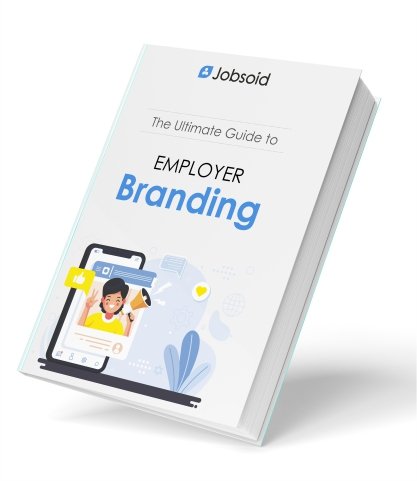Today’s HR relies a lot on employer branding and candidate experience in the recruitment process.
It is in your company’s best interest to showcase yourself as a serious, well-developed brand that top-talent are gravitating towards. In addition to this, employer branding is what channels your brand’s identity and your EVP, which top-talent job seekers are very receptive to.
The Impact of Employer Branding
On the hunt for the most talented and qualified employees, companies invest millions of dollars to dress up their employer brands. But it is not just a ‘dress to impress’ moment for the target audience. The potential job seekers indeed want to see how companies invest in employer branding and talent strategies.
According to a recent survey –
- 9 out of 10 job candidates would apply for a job from a company that actively maintains its employer brand.
- 64% of job seekers say they would reconsider taking a job at a company if they heard of cases of poor employee treatment. Employee experience and work environment thus plays a major role.
- 68% of Millennials visit a company’s social media channels in addition to its career site to evaluate its employer branding strategies.
However, above everything, top talent always considers your employer value proposition (EVP) in addition to analyzing how well you maintain your employer brand on various channels. EVP forms an integral part of employer branding.
EVP and Employer Branding: Eliminating All the Confusion
You may have seen several sources on the internet discussing the difference between employer branding and EVP. As mentioned earlier, EVP is an integral part of an employer brand. So, it rather complements employer branding than exists as an individual phenomenon.
Let us analyze the terminologies to understand the nature of these two notions better.
Employer Brand
This is a collective term that describes your company’s reputation and popularity ranks from your perspective as an employer. Your employer brand should ideally channel your brand values. It is a way to represent your company’s attractiveness as an employer. It is a way to demonstrate your company culture to all potential candidates.
Consequently, employer branding is a process or a set of actions you take to develop your employer brand. These actions represent the steps you take as an employer to attract top-talent employees to your company. These talent acquisition steps can involve building your business website, developing a social media strategy for advertising your talent brand, promoting employee engagement, developing a recruitment marketing strategy and a lot more.
Employer Value Proposition or EVP
Employer Value Proposition is a set of collective elements that employees within your company think of you as an employer. You can also say that EVP describes what your employees value in you as an employer.
Ideally, a strong EVP should reflect these three elements:
- the internal reality, i.e. what your employees think of you as an employer
- the external reality, i.e. your goals as an employer and a company
- your internal and external reality in correlation with your competitors and how they build their employer brands to retain top talent
EVP also involves a lot of research. “You cannot define EVP based on assumptions,” says Jennifer Harrison, an HR strategist at The Word Point. “EVP should be calculated through research, employee polling, as well as workplace analysis.”
Both employer brand and EVP work to build a clear image of you as an employer. They are also involved in helping to passively attract new talent as well as to actively engaging existing employees.
Employer brand and EVP – What is the Difference?
The reason why some people confuse these two notions is in a false perception that these are two separate phenomena. Instead, you should perceive both EVP and employer brand as phenomena that complement each other.
Simply put, EVP is what your company is famous for as an employer. However, what you are famous for is not always what you can control. This is the reason why you should analyze your EVP to define your strengths and weaknesses and then, use them to build your employer brand accordingly.
As an example, let us analyze the connection between EVP and employer brand in the example of Marriott Hotels.
The employees working in Marriott Hotels around the world praise their company for investing in corporate education. The company often sends its employees on different kinds of competitions, where they can both improve their skills and showcase their talent. They aim towards career development of their employees. Marriott Hotels has incorporated this ‘strength’ in its employer branding strategy.
Microsoft also follows the same pattern when it comes to their employer brand. Also famous for corporate education, they involve their employees to tell the story of how it is to work for Microsoft through a separate channel on Instagram which is also an amazing talent branding tool.
Both Marriott and Microsoft have analyzed the strengths that constituted their EVP and incorporated them in the strategy to build their talent brand. Thus, EVP is a constituent of an employer brand. You cannot equate EVP and employer brand, but rather use one to build the other.
Mission Statement and Corporate Brand
In order to build a strong brand, you need to define your company’s mission statement and your corporate brand.
Your mission statement would constitute who you are as a company, the core values, and principles you follow, as well as the efforts you make to live up to these values and principles. In contrast, your corporate brand is the public perception of your company, which you often cannot control. However, you can take advantage of it and use it to represent your mission statement better.
Thus, your EVP defines your identity as an employer through the perception of your employees. And, your employer brand is the steps you take to channel this identity to attract top candidates.
EVP involves analysis and research that can later be utilized in developing the employer branding strategy. For instance, you can start with internal research on the benefits that you offer to your employees as their employer.
This research may include the analysis of:
- salary and other forms of compensation (insurance, bonuses)
- workplace organization
- corporate education
- office perks, like corporate events and team building get-togethers
These should be real benefits that you can later use to market your employer brand and upgrade. For instance, you can market office perks as a part of your employer brand.
Take a look at Home Depot’s outstanding employer branding example:
Some companies that offer their employees the benefit of personal and child care leaves, also use it in their employer branding strategies. You can see it in Microsoft’s employer brand – they actively support the right of their employees to spend more time at home, especially when these employees come from family-centered cultures.
Recognizing the benefits you offer as an employer means recognizing your strengths that will later pay a defining role of your employer brand.
The Takeaway
EVP lays the foundation of the employer brand. You use it to create an image of how you want to be perceived as an employer. EVP is a research-based foundation, and your employee branding strategy is how you can use this research in a creative way for attracting talent and marketing yourself as an employer of choice.
What you should remember is that both EVP and employer branding only work in your favor if you stay true to what you are as a brand. Only then you can lay a strong foundation of what will become your employer brand.
Jobsoid provides advanced tools to help you establish and improve your branding efforts. You can sign up for a Free Account today and strengthen your talent brand.

 Erica Sunarjo
Erica Sunarjo 


